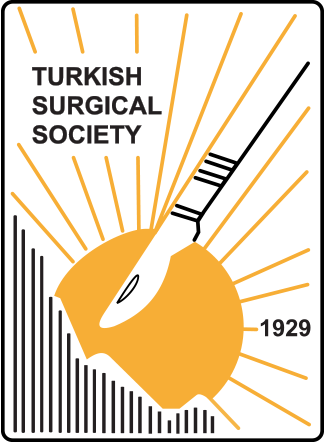Abstract
Purpose: Occult cystobiliary fistula is frequently encountered in hydatic liver disease that is usually overt in the postoperative period and leads to certain complications. In the present study it is aimed to evaluate the efficacy of methylene blue injection technique in determining the occult cystobiliary communication in the peroperative period.
Materials and Methods: Thirty five patients with the diagnosis of hydatic liver disease in whom conservative surgery has been performed were included in the study. The patients with biliary soiling of the cyst fluid and overt cystobiliary communication have been determined. In the remaining patient regardless of bile stain the common bile duct was isolated and methylene blue injection was performed.
Results: Of the eight patients with bile stain of the cyst fluid, a cystobiliary communication was shown in 5 (63%). In the remaining 3 patients (37%) in whom no communication could be demonstrated, methylene blue injection showed the communication. In the remaining 27 patients with no sign of cystobiliary communication methylene blue injection showed a communication in 6 (22%).
Conclusion: In hydatic liver disease in which conservative surgery has been performed methylene blue injection technique is a safe and effective procedure in the demonstration of occult cystobiliary communication
Keywords:
Hydatic liver disease, occult cystobiliary communication, methylene blue
References
1Sayek I, Yalin R, Sanac Y. Surgical treatment of hydatid disease of the liver. Arch Surg, 1980; 115: 847–850.
2Demircan O, Baymus M, Seydaoglu G, et al. Occult cystobiliary communication presenting as postoperative biliary leakage after hydatid liver surgery: are there significant preoperative clinical predictors? Can J Surg, 2006; 49: 177–184.
3Skroubis G, Vagianos C, Polydorou A, et al. Significance of bile leaks complicating conservative surgery for liver hydatidosis. World J Surg, 2002; 26: 704-708.
4Vignote ML, Mino G, de la Mata M, et al. Endoscopic sphincterotomy in hepatic hydatid disease open to the biliary tree. Br J Surg, 1990; 77: 30-31.
5Hankins JR. Management of complicated hydatid cysts. Ann Surg, 1963; 158: 1020-1034.
6Becker K, Frieling T, Saleh A, et al. Resolution of hydatid liver cyst by spontaneous rupture into the biliary tract. J Hepatol, 1997; 26: 1408-1412.
7Kayaalp C, Bzeizi K, Demirbag AE, ve ark. Biliary complications after hydatid liver surgery. Incidence and risk factors. J Gastrointest Surg, 2002; 6: 706-712.
8WHO Informal Working Group. International classification of ultrasound images in cystic echinococcosis for application in clinical and field epidemiological settings. Acta Tropica, 2003; 85: 253-261.
9Rutkauskas S, Gedrimas V, Pundzius J, et al. Clinical and anatomical basis for the classification of the structural parts of liver. Medicina (Kaunas), 2006; 42: 98-106.
10Zaouche A, Haouet K, Jouini M, et al. Management of liver hydatid cysts with a large biliocystic fistula: multicenter retrospective study. Tunisian Surgical Association. World J Surg, 2001; 25: 28-39.
11Karaliotas C, Zografos G. Prevention of postoperative bile leakage after major hepatic resections in malignancies. J Surg Oncol, 2000; 73: 236.
12Langer JC, Rose DB, Keystone JS, et al. Diagnosis and management of hydatid disease of the liver: a 15-year North American experience. Ann Surg, 1984; 199: 412-417.
13Kayaalp C, Bostancı B, Yol S, ve ark. Distribution of hydatid cysts into liver with reference to cystobiliary communications and cavity-related complications. Am J Surg, 2003; 185: 175-179.
14Özaslan E, Bayraktar Y. Endoscopic therapy in the management of hepatobiliary hydatid disease. J Clin Gastroenterol, 2002; 35: 160-174.
15Özmen M, Coşkun F. New technique for finding the ruptured bile duct into the liver cyst: scope in the cave technique. Surg Laparosc Endosc Percutan Tech, 2002; 12: 187-189.
16Sari YS, Tunali V, Tomaoglu K, ve ark. Can bile duct injuries be prevented? “A new technique in laparoscopic cholecystectomy”. BMC Surg, 2005; 5: 14.
17Karaliotas C, Zografos G. Prevention of postoperative bile leakage after major hepatic resections in malignancies. J Surg Oncol, 2000; 73: 236.
18Miliçeviç H. Hydatid disease. In: Blumgart L, Fong Y, eds. Surgery of the liver and biliary tract. 2nd ed. Philadelphia: WB Saunders Company, 2000: 1167-1204.
19Yalin R, Aktan AÖ, Yegen C, et al. Significance of intracystic pressure in abdominal hydatid disease. Br J Surg, 1992; 79: 1182-1183.
20Atli M, Kama NA, Yüksek YN, et al. Intrabiliary rupture of a hepatic hydatid cyst associated clinical factors and proper management. Arch Surg, 2001; 136: 1249-1255.



